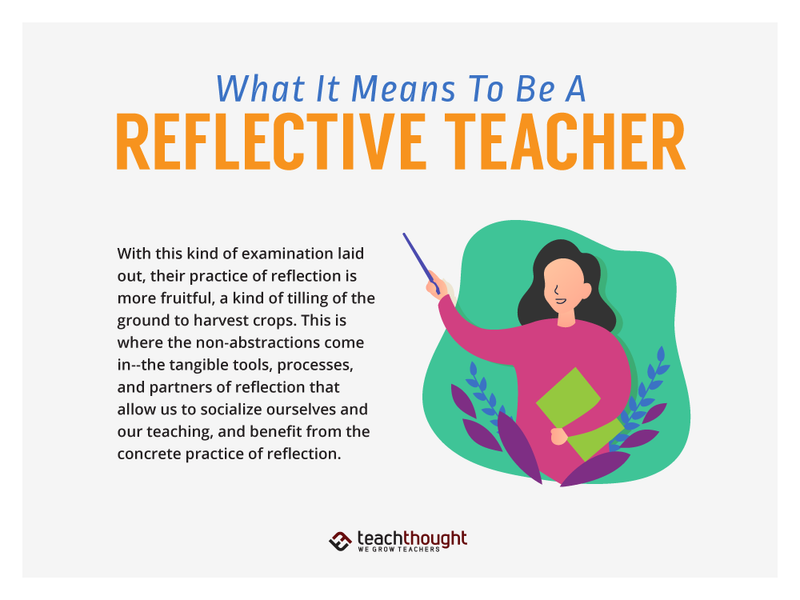by Terry Heick
Reflection is a fundamental tenet of learning; it is also, therefore, a fundamental part of teaching.
Why it happens is a matter of humility. But how and when it happens–and with whom–is less clear. This is partly because there are multiple sides to reflection–length, width, and depth. A Z-axis.
It is whole.
As a kind of definition, to reflect means to look back at how something ‘went,’ and see it for all of its available parts and patterns: Causes and effects; comparisons and contrast; strengths and weakness; its characteristics; how close it came to what you were expecting; your emotions.
I planned this, and it went like this, and now I think this.
Reflection, then, is the bridge between what we do and what we can do better. It’s the pause that allows improvement, the silence that precedes understanding. And while it can seem like an abstract ideal, its effects are anything but.
What Does Reflection Look Like?
Reflection in teaching might look like this:
A teacher pausing at the end of a lesson to jot down a quick note: What went well? What didn’t? How did the students respond?
Collaborative conversations during professional learning communities (PLCs): Sharing successes, analyzing failures, and considering alternative strategies.
Reviewing student work with curiosity rather than judgment: What does this tell me about how they think? What gaps do I see? What strengths can I build on?
A mental replay at the end of the day: Thinking through moments that stood out—successes, struggles, surprises—and unpacking why they mattered.
Reflection doesn’t always require structure, but structure can help. It’s a way to make reflection a habit instead of an afterthought. Reflection can happen alone or with others, formally or informally, in writing or in thought.
Tools for Reflection
To make reflection practical and actionable, consider tools like:
Journaling: Keep a simple teaching journal. At the end of each day, write down three things: what worked, what didn’t, and what you’re curious about for tomorrow.
Checklists or rubrics: These can be used to evaluate lessons or teaching strategies against specific criteria.
Student feedback: Regularly seek input from students about what helps them learn. This can be through surveys, open-ended questions, or informal discussions.
Video recording: Recording a lesson and reviewing it can offer an objective view of your teaching in action.
Reflection as a Shared Practice
Reflection doesn’t have to happen in isolation. Collaborating with peers adds new perspectives and uncovers blind spots. When teachers share their reflections, it normalizes the practice and creates a culture of growth within a school.
Ask colleagues: What’s one strategy you’ve used that worked well recently? What’s a challenge you’ve been reflecting on?
Participate in reflective protocols: Structured discussions like the “Critical Friends” protocol provide a framework for sharing and analyzing teaching practices.
The Benefits of Reflection
The benefits of reflective teaching ripple outward. For teachers, it fosters professional growth, sharpens self-awareness, and reignites purpose. For students, it creates better learning experiences and models the lifelong learning process.
Reflection isn’t about achieving perfection but about continuous improvement. It’s the practice of aligning your actions with your beliefs, ensuring that your teaching reflects your core values and best intentions.
Reflection sounds like an abstract idea–something unspecific, and even a little mystical. Something we do in the shower on the drive home when no one’s around and we’re free to roam in our own minds. It’s definitely true that reflection comes most effortlessly, and in its purest and rawest forms, in those circumstances when we–that is, our minds–are not otherwise engaged.
Reflection isn’t a single thing–a box to check in some elliptical cycle of learning. It’s as much a matter of self-awareness, humility, and affection as it is timing, sequence, and procedure.
I can see the craft of teaching as both a sequence of steps and the fulfillment of design. It’s both parts and whole. Science and art. Professional and people.
I know nothing is ever perfect, so I seek to improve. I also know what’s improvable within my means, and what pathways there are to get there.
I believe in the endurance of knowledge and understanding, and will bring everything I know to bear on my craft.
With this kind of examination laid out, their practice of reflection is more fruitful, a kind of tilling of the ground to harvest crops. This is where the non-abstractions come in–the tangible tools, processes, and partners of reflection that allow us to socialize ourselves and our teaching, and benefit from the concrete practice of reflection.
The Role Of Reflection In Teacher Improvement
When I use social media, I do so both as a matter of practice and thought. Mechanical actions lead to thought, and the other way around. I skim social channels, check mentions and messages, and respond if it makes sense. These are inputs. The output, if I get it just right, is reflection.
If I read a tweet, interpret what I believe to be its meaning, find relevance in its message, and think–even briefly–about how I relate to it and it to me, I’m approaching reflection.
Tweet: The Building Momentum Behind Social Emotional Learning
My reaction: What’s the ‘big idea’ of social-emotional learning? What do I know–and not know? What tools am I aware of that could work here? Do I need a tool–is this worth clicking on? Should I save to Pocket without clicking? Click and read? RT without reading? Read, then RT? Favorite with or without reading? How am I spending my time right now on social media? Am I bumming around, or should I be more intentional–this tool or idea for this need I have tomorrow.
If reflection happens on social media–and it does–then it is both a matter of practice and habit–a tendency towards the kind of thought that promotes change in your teaching. But this really has nothing to do with twitter; this is just an easy example that many of you can relate to. It’s about the dimensions of reflection: The How, the When, and the Who.
How Does Reflection Happen?
You could start with prompts for reflective teaching. These–or others–can be about looking at the ins and outs of teaching as long as they lead to your building both a capacity and a tendency to reflect on your own.
There is, of course, vulnerability that comes with reflection. Being honest, transparent, and then standing on your own.
The reflection actually starts much earlier, alone, in your own mind after something happens. Then, it often happens with someone–a friend, colleague, or loved one. Maybe even a student. Then, you’re likely to reflect again, alone, now pushed further in your thinking by the ‘together’ part. Writing about it again, and then sharing that with others makes the reflection more complex, and more personal.
Sequence: Alone–>Together–>Alone
Reflection, among other patterns, often happens Alone (which is slow and passive), Together (which is more immediate, and active) and then Alone Again (once more, slow and passive).
Sequence: While Teaching–>After Teaching–>After School
Reflection is also a matter of timing. Reflection can happen at any time, but no sooner than the event begins taking place: The lesson, the assessment, the meeting, the Socrative Discussion.
While teaching, how is it going really? What adjustments seem necessary? What’s most important here? Then immediately after, how did it go (evaluation), and how do I know (data)? After school, now that I’ve had a chance to ‘get away’ from the event some, what do I think now? What’s lingering? What should I do differently next time? What would students say if they were right here next to me?
Sequence: Students–>Colleagues–>PLN
And then, with whom should I reflect? Students? Colleagues? Professional Learning Networks? My spouse? How is each episode different? What’s worth talking about and worth forgetting?
How can I see reflection as a way of teaching so that it’s impossible to separate out and itemize, but is instead a moment-by-moment thing that is always with me like a heartbeat?
What It Means To Be A Reflective Teacher






Leave a Reply